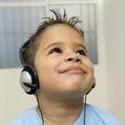-
assistive
listening device: a device such as a FM system that emits enhanced
speech signals to the user; an assistive listening device improves the
signal-to-noise ratio and helps to overcome barriers in the listening
environment, such as distance from the speaker, background noise, and
reverberation
-
auditory
analysis: the
ability to identify phonemes or morphemes embedded in words
-
auditory
association: identifying an acoustic signal and association
with its source or labeling a linguistic or nonlinguistic sound or experience
-
auditory
attention: ability to focus on relevant acoustic signals, particularly
speech or linguistic stimuli, and sustain that attention for an age-appropriate
amount of time
-
auditory
closure: ability to understand the whole word or message when
a part is missing (in noisy listening environments this is an often-used
skill in order to comprehend messages)
-
auditory
discrimination: the skill necessary to distinguish words and
sounds that are acoustically similar
auditory figure-ground: ability to identify the primary
linguistic or nonlinguistic sound source from a background noise
-
Auditory
Integration Training: an
intensive listening intervention involving.10 hours over 10 or 12 days
following the Berard AIT protocol
-
auditory
memory: the
recall of the acoustic signal after it has been labeled, stored, and
then recalled
-
auditory
overload:
occurs when the listener’s auditory system is unable to efficiently
process incoming auditory information.
-
auditory
sequential memory:
the ability to recall the order of a series of details
-
auditory
short-term memory:
ability to retain auditory information as immediately presented
-
auditory
synthesis:
ability to synthesize (i.e., merge or blend) isolated phonemes into
words
-
binaural
integration:
listener is required to process different information presented to both
ears simultaneously and repeat everything that is heard in both ears'
binaural interaction: listener must attend to complementary but different
pieces of information presented to each ear and then integrate the information
to perceive the whole message
-
binaural
separation:
listener is required to process an auditory message delivered to one
ear while ignoring a dissimilar message presented to the opposite ear
at the same time
-
central
auditory nervous system (CANS):
the pathway of auditory signals to the brain beyond the peripheral hearing
mechanism
-
dichotic:
a
different stimulus presented to each ear simultaneously
-
diotic:
presentation
of the same sound to both ears
-
directional
microphone: a
microphone used with an FM system that eliminates lower frequencies
that can mask consonant sounds; able to operate at high output levels
without feedback
-
discrimination:
the process used to discriminate among sounds of different frequency,
duration, or intensity (e.g., high/low, long/short, loud/soft)
-
electrophysiologic
tests:
evaluation of the neuromaturation and neuroplasticity of the central
auditory pathways
-
FM:
an acronym for frequency modulation; modification of the frequency signal
on a carrier wave
-
FM system:
an assistive listening device consisting of a microphone, transmitter,
and receiver; signal is transmitted by FM radio waves
-
HL:
hearing level measured in decibels
-
localization:
ability to determine the location of the acoustic signal relative
to the listener’s position in space
-
metacognition:
appropriate use of knowledge to plan, monitor, and regulate
performance, including attention, memory, listening, learning, and language
processing
-
metalinguistic:
strategies
to improve listening and spoken language comprehension (e.g., discourse
cohesion devices, schema induction, linguistic closure and context-derived
vocabulary building, prosody, segmentation)
-
monotic:
presentation of a sound stimulus to only one ear
-
omnidirectional
microphone: a microphone used with an FM system when the signal-to-noise
ratio is 15 dB or greater
-
peripheral
hearing: the
auditory mechanism including the outer, middle, and inner ear
-
sensation:
the
ability to identify the presence of sound
-
SL: sensation
level expressed in decibels; the number of decibels above a reference
point such as the Spondee Threshold
-
signal-to-noise
(S/N) ratio:
the ratio of the signal to the corresponding noise (for example, a +5
dB S/N means that the primary signal is 5 dB louder than the noise competition)
-
speech
recognition testing:
measurement of speech identification ability
-
Spondee
Threshold: the lowest hearing level in dB at which 50 percent
of spondee words (bi-syllabic words with equal stress on each syllable)
are identified correctly
-
temporal
processing:
discrimination of sound based on a sequence of auditory stimuli or temporal
order






